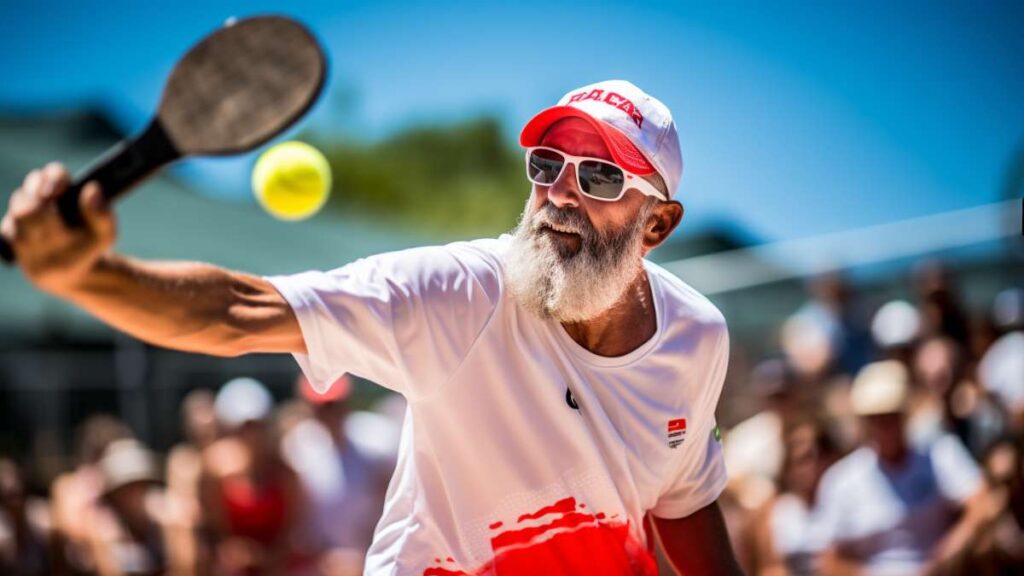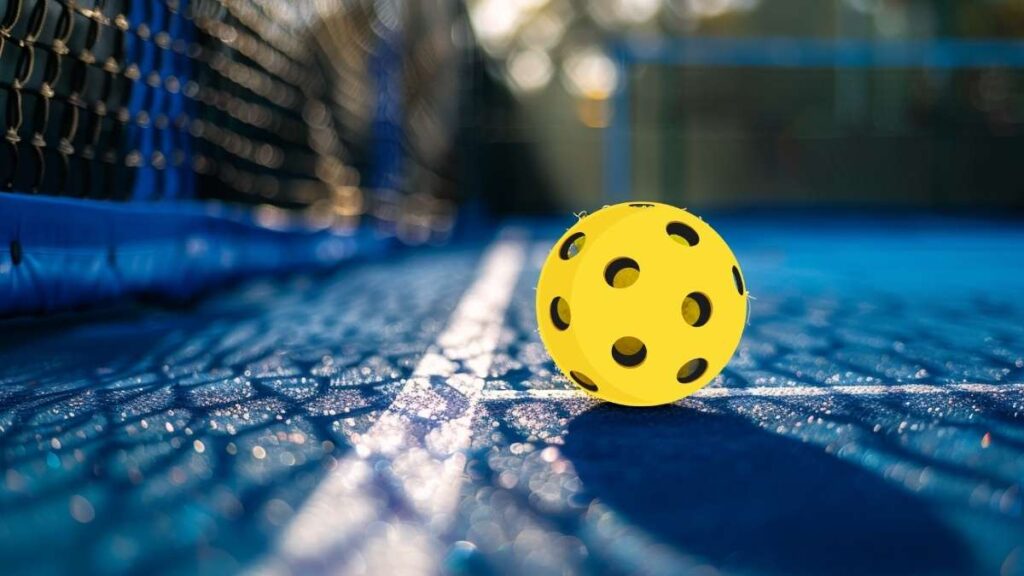Staying ahead in pickleball means keeping up with the latest serving rules. Starting in 2024, players will see important changes to how they serve up the competition. Our guide breaks down these new regulations into easy-to-understand points, ensuring you’re ready for every match.

Dive in for a winning edge on the court!
Before serving in pickleball
Before serving in pickleball, it’s important to call out the score to ensure both players are on the same page. This helps maintain a fair and competitive game.
Calling out the score
You must shout the score before you serve in pickleball. It’s a rule that ensures everyone knows what’s going on, keeping the game fair. Not doing this can lead to penalties or even give points to the other team.
The USAP rules committee made it clear: clear communication is key for a good match.
Imagine serving without letting anyone know the score—confusion would spread fast! That’s why this new rule matters so much in tournament play. Do you want a game where every point counts and fairness stands tall? Then calling out loud and clear is your best bet.
Plus, it shows respect for all players and keeps things smooth on the court.
Serving specifics
The new pickleball serving rules in 2024 will outline specific details about the crosscourt serve and allow ball contact within the crosscourt. If you want to learn more about these serving specifics, keep reading!
Crosscourt serve
Mastering the crosscourt serve is key in pickleball. You must send the ball diagonally over the net to your opponent’s serve court. It can bounce on any line within that area, except for the non-volley zone line.
If it lands there or outside this section, you’ve made a fault.
Keep practicing until you get it right every time. Aim for precision and control over power – that’s what wins games in pickleball. Your serves need to be spot-on if you want to outplay your competition and score those points!
Allowed ball contact within the crosscourt
You must serve the ball crosscourt in pickleball. The ball can hit any line within that area, but it must avoid the non-volley zone line. If you don’t follow this rule, your serve counts as a fault according to USA Pickleball regulations.
Keep in mind, hitting those lines is just fine! It’s all part of the game and can be a smart way to catch your opponent off guard. Just focus on landing it in the right section and you’ll keep the rally going strong.
Scoring points
A player scores a point in pickleball if their serve hits the opponent or if the return does not clear the net or lands out of bounds, so make sure to familiarize yourself with these new serving rules for an edge on the court.
Serve hitting opponent
The serve hitting your opponent scores a point, irrespective of intent. This is colloquially called the “nasty Nelson,” named after a player known for using this tactic.
These rules make it crucial to strategize and execute serves effectively, as the consequences can significantly impact the game’s outcome.
Rules concerning the server’s position
The server must position its feet behind the baseline before making contact with the ball. Additionally, they are not allowed to touch the baseline or step inside the court during serve, and their position should not extend past an imaginary line.
Feet position behind the baseline
The server must position at least one foot behind the baseline when serving. The rules strictly prohibit any part of the feet from touching the baseline or the court inside it while making a serve, maintaining fair play, and consistent positioning on the court.
Additionally, servers are not allowed to stand beyond an imaginary extension of either the midsection of the court or the exterior sideline, ensuring an equal advantage for both players during serves.
Restrictions on touching the baseline or court inside the baseline
When serving in pickleball, adhering to the rules regarding your position is crucial. The server must keep at least one foot behind the baseline during serve and should avoid any contact with the baseline or inside the court.
This rule helps maintain fairness and consistency in gameplay while ensuring players serve from the designated area. Adhering to these guidelines is essential for a fair and competitive match.
As servers play their role, they must be mindful of their positioning behind the baseline. Keeping distance from the court inside ensures that serves are made within regulation boundaries, contributing to a standardized and equitable playing environment according to USA Pickleball Rules Committee standards.
Server’s position past the imaginary extension
The server cannot stand past the imaginary extension of the court’s midsection or the exterior sideline. At least one of the server’s feet must be behind the baseline, and no part of their feet may touch the baseline or court inside it.
Ensure that servers adhere to these rules for fair play and a level playing field.
Handling of the ball during serve’s

Handling the ball during serve includes the execution of a single-handed serve and ensuring natural ball release for fair and legal play.
To learn more about the new pickleball serving rules for 2024, make sure to read through the full blog post!
Single-handed serve execution
A pickleball must be served single-handedly, adhering to the 2024 rules. The server must hold the ball with one hand and release it naturally without any prior manipulation or spinning.
This ensures fair play and consistency in the serve execution across all game levels. The visibility of this single-handed serve action is crucial, as it needs to be observable by both the referee and the receiver, adding transparency to the serving process.
The server should execute the serve using only one hand while avoiding any kind of manipulation or spinning of the ball before its release. This adds fairness and consistency to how serves are performed.
Natural ball release
The server must release the ball naturally without any manipulation or spinning. This ensures fairness and maintains the integrity of the serve, as it prevents any unfair advantage gained through artificial manipulation of the ball before serving.
Any attempt to alter the natural release of the ball is strictly prohibited, aligning with the principles of fair play in pickleball.
During officiated matches, visibility is crucial, and both the referee and receiver must be able to witness the natural release of the ball by the server. This rule emphasizes transparency and accountability in ensuring that all serves are executed within the boundaries of fair play.
Visibility of the serve
The new pickleball serving rules in 2024 require visibility of the serve to both the referee and receiver, ensuring fair play and adherence to regulations. Intrigued? Keep reading for more details on the updated serving guidelines.
Requirement for visibility to the referee and receiver
The server must release the ball in a way that is visible to both the referee and the receiver during officiated matches, ensuring fairness and transparency in the serving process.
This rule aims to prevent any potential advantage gained through obscured ball release, promoting an equitable playing environment for all participants.
By adhering to this requirement, players uphold the integrity of the game while also demonstrating respect for their opponents and officials. It emphasizes sportsmanship and fair play, ultimately contributing to a more enjoyable pickleball experience for everyone involved.
Types of serves allowed
The volley serve and the drop serve are two types of serves allowed in pickleball, each with its own unique technique and strategic advantage. Understanding the differences between these serves can help players improve their overall game and gain an edge over their opponents.
The volley serve
The volley serve is executed by striking the ball before it touches the ground. It requires an upward arc motion of the server’s arm and must not be initiated above waist level, with the waist defined as the navel.
The drop serve
The drop serve in pickleball involves striking the ball after it has bounced on the playing surface. There are no restrictions on the number of bounces or the location of the bounce before the serve.
The server must release the ball from one hand or drop it from the paddle face without propelling it in any specific direction before serving.
In this type of serve, there is freedom for creativity and strategic placement without being constrained by a rigid set of requirements. It offers an opportunity for players to surprise their opponents with unexpected placements and add variety to their serving techniques, potentially giving them an edge during matches.
- Related Read: 2024’s Highest Paid Pickleball Player
Final Thoughts
In conclusion, the 2024 pickleball serving rules bring crucial updates for tournament play. Servers must announce the score before serving and execute a crosscourt serve within specific boundaries.
Point scoring has been redefined, emphasizing fairness and skill. Additionally, players must adhere to strict guidelines regarding their position and handling of the ball during serve.
The new regulations aim to elevate the sport’s competitive standards while ensuring a level playing field for all participants.
FAQs
What are the major changes in pickleball serving rules for 2024?
Starting in 2024, new pickleball rules include rally scoring to speed up games and specific paddle specifications to ensure fair play. Plus, there’s a carry rule—rule 7. l that clarifies what motions players can’t do.
Can I take a break if I get hurt during a game?
Yes, you have the option for medical time-outs if you’re injured. Safety first! And remember, each time-out follows guidelines set by tournament directors.
Are all paddles okay to use under the new rules?
Watch out—paddles need to meet specific standards now. If your paddle doesn’t match up with the latest technology requirements or is considered illegal, you’ll be switching it out!
Will someone watch our non-officiated games to check we follow these rules?
Usually not; players often call their shots during non-officiated play, but playing fair is part of the fun! However, for those big-deal matches with referees? Those pros handle everything from line calls to deciding when rally replays happen.
Is spin serve still allowed in pickleball under these new regulations?
Absolutely—the spin serve is still in the game; just make sure your serves respect the updated paddle specs and carrying isn’t involved as per rule 7. l.


Leave a Reply